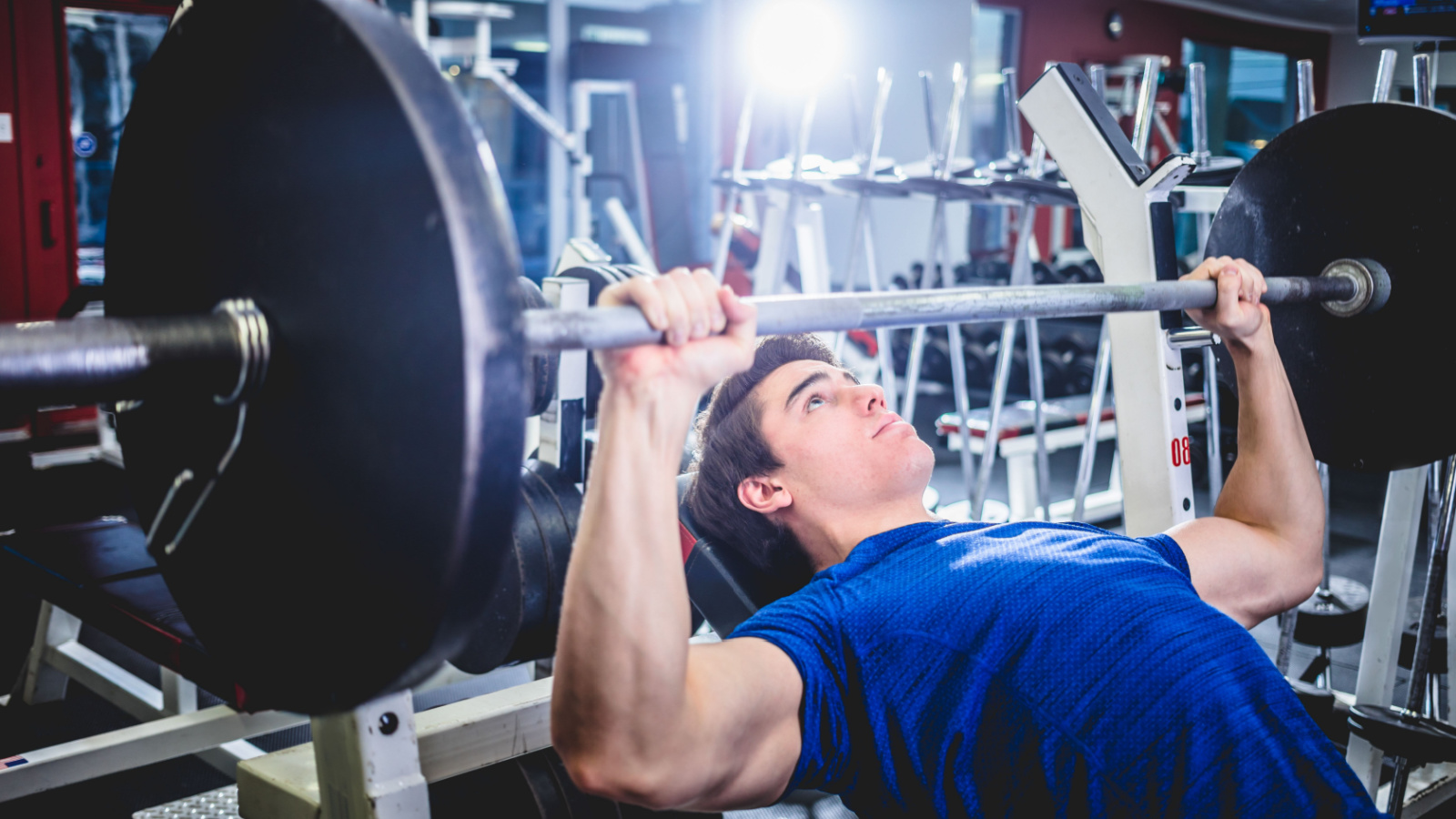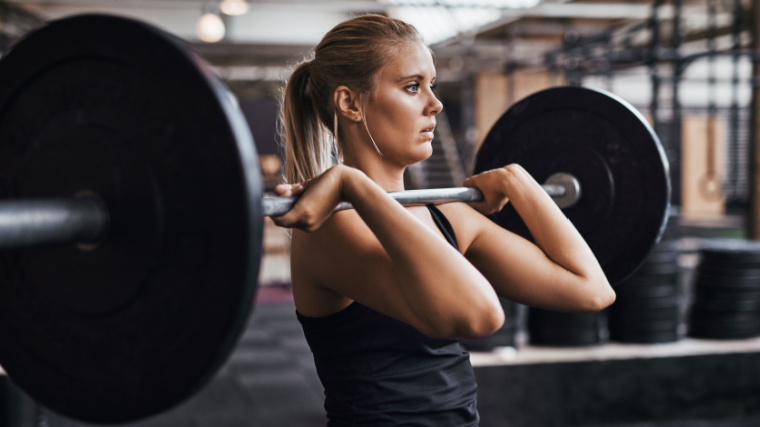
Something magical happens near the beginning of every dedicated lifter’s love affair with resistance training. There’s a period of unprecedented gains in strength and size. Some refer to the muscular adaptations realized during this stage as “newbie gains.”
Don’t let the derogatory connotation fool you. Newbie gains are awesome. You’ll hit frequent personal bests, stack on pounds of lean muscle mass, and dial-in natural lifting technique.

What’s the best way for a new lifter to take advantage of this honeymoon period of gains? Easy. Get your hands on a weight set and train consistently with the basic barbell lifts. Built around barbell basics, this program provides everything you need for serious muscle.
Beginner’s Barbell Workout
How to Warm-up for Your Barbell Workout
Starting a workout cold may lead to reduced performance, so learn good habits from the start. Don’t skip your warm-up. Warm-ups typically begin with a four-to-six-minute session of cardio to increase body temperature and circulation, ultimately improving oxygen delivery to your muscles and improving metabolite clearance. Common options for the cardio warm-up include skipping rope, riding a stationary bike, or taking a quick jog.
Next, mobilize and activate the joints and muscles of the body involved in the upcoming workout. Since you’re warming up for a full-body workout, you could burn a lot of gym time here, so it’s best to focus on a few key areas such as your hips, shoulders, and spine. Below is a two-movement mobility and activation sequence for these regions. Perform three rounds of following movements:
- Plank to Pike with Alternating Reach: Assume a “high plank” position — the top position of a push-up — then use your upper body to push your hips back over your heels until you feel a hamstring stretch. This “upside down V” is called the pike position. Maintain the pike position and reach your right hand toward your left foot, return your hand to center, then reach your left hand toward your right foot. Return to a high plank by lowering your hips. That’s one repetition. Perform 8 repetitions.
- Plank to Deep Lunge with Rotations: Begin in the high plank position and drive your left leg forward and plant your foot as close to the outside of your hand as your mobility allows. Then, lift your left hand and reach out and up toward the ceiling as you rotate your trunk to the left as far as you can. Rotate back and return your hand to the floor, then step back to high plank. Repeat on the right side. That’s one repetition. Perform 8 repetitions.
Once you finally get your hands on the barbell, remember to perform several “work-up sets” of each exercise using lighter weights. Work-up sets allow you to dial-in technique and help you to identify appropriate weights for the sets that count.
Barbell Basics for Size and Strength
A barbell with plates is possibly the most versatile tool for resistance training. In addition to being the requisite piece of equipment for common exercises, it’s loadable, allowing you to scale the intensity of your training to your current level of strength. Paired with an adjustable bench and sturdy rack, a barbell set gives you the means to train your entire body.
Fortunately, beginner lifters don’t need to live at the gym to experience newbie gains. A large meta-analysis compared the effects of less than five weekly sets per muscle group, five to nine weekly sets, and ten or more. (1) For hypertrophy and strength results, this analysis concluded beginners and novice lifters should target five to nine sets per week per major muscle group. (1)
Of course, this recommendation does not imply all sets should be performed in the same workout. Full-body workouts help to maximize training frequency, or the number of times each muscle group is trained per week. Higher frequency training allows for greater weekly sets while avoiding marathon-length workouts.
The workout below consists of 15 sets of barbell exercises. If repeated two or three times per week, this workout puts beginner and novice lifters squarely into the target range for weekly sets. (1) It might be the only resistance training program you need to take your physique from entry-level to next-level.
Barbell Basics Workout Plan
- Front Squat — 3 x 6-10
- Bench-Supported Barbell Row — 3 x 8-12
- Romanian Deadlift — 2 x 8-12
- Incline Bench Press — 3 x 6-10
- Barbell Rollout — 2 x 12-16
- Barbell Curl — 2 x 8-12
Front Squat
Set the tone of your workout by hitting squats first. Specifically, front squats, which hammer your thighs and glutes. The front squat differs from the back squat in several ways. First, as the name implies, the front squat requires carriage of the bar in front of the body, while back squats are performed with the bar across the upper back.
The front carriage or “front rack” position may be more forgiving for those with shoulder instability, and it tends to promote a more upright trunk position. Compared to back squat, the front squat also tends to require relatively less weight to elicit a similar training effect. (2)
Why favor an exercise that uses less weight? This is a full-body workout, and we are just getting started. Less load spares the body from excessive fatigue accumulation, which might interfere with subsequent exercises. Front squats will toast your quads without burning through all your matches.
- How to Do it: Set up for the front squat by placing the bar at chest height in the rack. For safety, set the spotter arms to approximately one increment below the lowest point you anticipate the bar reaching during the movement. Place your fingers over the bar, slightly outside shoulder-width and dip under the bar as you point your elbows straight ahead. Step back a half step from the rack, place your feet approximately shoulder width, and squat down, keeping your elbows high and chest up. Descend as far as possible while remaining upright with heels on the floor, then return to standing.
- Sets and Repetitions: 3 x 6-10
- Rest time: Rest three minutes between sets .
Benefits of the Front Squat
- The “front rack” bar position promotes an upright trunk, which may be beneficial for lifters who tend to fold excessively forward during squats.
- Front squats build big, strong quadriceps. Quadriceps can be further biased by placing wedges or small plates under the heels.
- The exercise promotes athleticism. Front squats have direct carryover to Olympic weightlifting movements (i.e., clean & jerk) and are shown to improve vertical jump performance more effectively than heavy hip thrusts. (3)
Bench-Supported Barbell Row
The next exercise is an upper body pulling movement. Barbell rows are known to build wide lats. This bench-supported variation spares your spinal erectors (the lower back muscles that support your back) for the next exercise. (4) Spoiler alert: deadlifts are next, so you’ll need a fresh set of erectors. In addition to your latissimus dorsi, barbell rows hit your rear deltoids and trapezius. (4)
The bench support also allows you to dial-in natural rowing technique because you do not have to worry about maintaining trunk or hip positions as in the bent over row. Rows should involve the entire shoulder complex, not just the ball and socket joint of the shoulder. Meaning when you pull, your shoulder blades out to retract, or squeeze together. To re-enforce proper shoulder blade movement, focus on creating more space between the front of your shoulders and floor as you row the barbell. (5)
- How to Do it: Set an adjustable bench to a roughly 35-to-45-degree angle. Lie on your stomach with your chest supported by the top several inches of the bench. Grasp the barbell with an overhand grip slightly beyond shoulder-width. Draw the bar toward the underside of the bench, then return to the bottom position, ensuring motion comes from the shoulder joint and shoulder blades.
- Sets and Repetitions: 3 x 8-12
- Rest time: Rest two minutes between sets.
Benefits of the Bench-Supported Barbell Row
- The bench support prevents unnecessary fatigue and allows for greater focus and emphasis on the target muscles — lats, mid-back, and rear delts.
- Using a moderate-width, overhand grip promotes balanced development of mid-back and lat muscles for back thickness and width.
- The bench-supported row is great for shoulder health. In addition to building your back, rows train the rotator cuff, namely the subscapularis, as a dynamic stabilizer. (6)
Romanian Deadlift
When programmed earnestly, conventional deadlifts tend to be unforgiving. They place heavy demands on your grip, trunk, and legs. The Romanian deadlift (RDL) is a deadlift variation beginning at the top position of the lift and executed with minimal bend at the knees. It’s a smarter barbell lift for targeting hamstrings at this stage of the workout.
Following the same rationale as programming front squats rather than back squats to reduce systemic demand and ensuing fatigue, the RDL is favored for this full-body workout. At 70% of one-repetition maximum, conventional deadlifts and RDLs place similar mechanical demands on the hips and show similar hamstring muscle activity. (7)
However, the RDL one-repetition maximum is substantially lower than the conventional deadlift. Sure, conventional deadlifts are shown to hit the quadriceps harder than RDLs, but you’ve already toasted your quads with the front squat. (7) Savor the stretch of RDLs as you build an impressive set of “hanging hamstrings.”
- How to Do it: Stand with either an overhand or mixed (“over/under”) grip on the barbell. Maintain a slight bend in your knees as you lower the bar by bending at the hips. Lower the weight until you feel a strong stretch behind your thighs in the bottom position, then return to standing. Keep your torso stiff as you bend at the hips and avoid curving your back forward.
- Sets and Repetitions: 2 x 8-12
- Rest time: Rest three minutes between sets.
Benefits of the Romanian Deadlift
- The RDL builds “strength at length.” By keeping your knees relatively straight while you bend forward at the hips, you stretch the hamstrings under load, which promotes simultaneous gains in hypertrophy and flexibility. (8)(9)
- Romanian deadlifts activate the hamstrings to similar levels as conventional deadlift. (7) RDLs likely exposes the hamstrings to greater tension due the increases stretch across three of the four hamstring muscles — semitendinosus, semimembranosus, and biceps femoris long head.
Incline Bench Press
No full-body barbell workout is complete without a press. Rather than default to the ever popular bench press or classic military press, we’re striking middle ground by programming the incline bench. The incline bench press not only hits the middle and lower fibers of your pectoralis major — the largest and most prominent chest muscles — but it also hammers the upper (clavicular) fibers. (10) Since your shoulders are trained through a larger range of motion, the incline bench press is also an effective choice for building your deltoids, specifically the front portion.
Still not convinced the incline bench is the right press for you? Results of an eight-week training study showed similar gains in muscle thickness in the middle and lower regions of pectoralis between a group training exclusively traditional bench press and a group training exclusively incline bench press. (11) However, the thickness gains were significantly greater in the upper pectoral region for the incline bench group. (11)
Most surprisingly, improvements in a lab-based test of horizontal pressing strength at the end of the study were similar between groups. (11) As a disclaimer, those looking to compete in the sport of powerlifting should still program traditional bench press, as the principle of training specificity still applies.
- How to Do it: Set an adjustable bench to the 45-degree incline position. Retract your shoulder blades so they lie flat when you lean against the pad with an arched back. Ensure the spotter arms are positioned one notch lower than your anticipated range of motion. Take a closed overhand grip on the bar, ensuring the bar rests on the heels of your hands. Keep your forearms vertical and bend at the elbows to lower the bar to your mid or upper chest. Avoid bouncing the bar off your chest before driving it back up to the lockout position.
- Sets and Repetitions: 3 x 6-10
- Rest time: Rest two minutes between sets.
Benefits of the Incline Bench Press
- The incline bench press delivers robust chest training by hitting all parts of your pectoralis major, as well as your front deltoids and triceps. (10)
- Incline pressing builds mid and lower pec size (sternocostal head) while also building strength similarly to the traditional flat bench press, with the added benefit of stacking on more upper pec muscle (clavicular head). (11)
- Working on an incline delivered efficient results while requiring about 20% lower weights than traditional bench press. (12)
Barbell Rollout
The front squat and RDL have already trained your spinal erectors (the core muscles on the back of the trunk), but no exercise so far has directly targeted the anterior core, or abdominals. Enter the barbell rollout exercise. Essentially, it’s an ab wheel rollout performed with a barbell and plates. Sure, you could use the cheap plastic, purpose-built device, but wouldn’t you rather chisel your abs with steel rather than something that looks like it was lifted from a toddler’s tricycle?
Exercise biomechanics of the barbell rollout are virtually identical to the classic ab wheel rollout. The ab wheel rollout is known to produce higher upper abdominal, lower abdominal, and external oblique muscle activity that crunches and reverse crunches. (13) In addition to training your anterior core, the rollout also hits your shoulder extensors. (13)
Since these shoulder muscles are trained through a relatively long range of motion, the rollout may provide added benefits of shoulder mobility and latissimus dorsi flexibility. (9) Ultimately, if you are not accustomed to this style of core training, get ready for serious delayed onset abdominal soreness.
- How to Do it: Load a plate and a collar on each side of the barbell. Kneel in front of the barbell and take a shoulder-width overhand grip. Use your abdominals to draw your rib cage slightly downward and tilt your pelvis slightly back — “tuck your tail.” Keeping your hips extended and without allowing your spine to arch, roll the bar forward as far as you can comfortably control. Use your shoulders to pull yourself back to an upright position.
- Sets and Repetitions: 2 x 12-16
- Rest time: Rest 30 to 60 seconds between sets.
Benefits of the Barbell Rollout
- The rollout is an anti-extension abdominal exercise that also builds shoulder strength and mobility.
- Barbell rollouts tend to be more challenging than other common core exercises, such as crunches and reverse crunches.
- Rather than adjusting the weight, the barbell rollout can be made less difficult by limiting your range of motion forward.
Barbell Curl
No weight training workout is complete without “pump work” for the glamor muscles. Everyone’s favorite showcase muscle, the biceps brachii, will have received some training stimulus during the row, but you cannot earnestly count those as three sets of biceps training. (14)
As old school as it may feel, the straight barbell is an effective choice for building big strong arms. During the downward movement phase of the exercise, the barbell curl elicits more biceps brachii activity than the dumbbell curl. (15) During the upward movement phase, the barbell curl is more effective than the dumbbell curl for stimulating muscle activity in the brachioradialis muscle, the thumb-side muscle that crosses in front of your elbow. (15)
Finally, from a practical standpoint, the straight barbell always stays in front of your body during curls, which keeps tension on the target muscles. Compared to dumbbell curls, it is much more difficult to “cheat” on barbell biceps curls by swinging the weight.
- How to Do it: Stand upright with an underhand shoulder-width grip on the barbell. Keeping your arms at your sides or slightly in front of your ribs, curl the barbell by flexing your elbow. Maintain a vertical torso and don’t use your hips to swing the weight. Return to the bottom position with control.
- Sets and Repetitions: 2 x 8-12
- Rest time: Rest 30 to 60 seconds between sets.
Benefits of the Barbell Curl
- Barbell curls are equally effective to EZ-bar curls for activating the biceps brachii. (15) However, barbell curls require full forearm supination throughout the movement, which may further emphasize your biceps brachii. (16)
- For those interested in forearm training, barbell curls appear better suited for training brachioradialis than the dumbbell curl. (15)
Maximizing Your Iron Investment
This 15-set, barbell-only workout hits all major muscle groups. For best results, perform it two or three times per week with at least one full day of recovery between sessions.
As your strength and muscularity steadily increase, you might come to realize your weight set (or gym membership) was the best investment you’ve ever made. But there’s no such thing as passive return on this investment. Even “newbie gains” require regular deposits of sweat and effort.
References
- Ralston, G. W., et al. (2017). The effect of weekly set volume on strength gain: a meta-analysis. Sports Medicine, 47, 2585-2601.
- Bird, S. P., & Casey, S. (2012). Exploring the front squat. Strength & Conditioning Journal, 34(2), 27-33.
- Contreras, B., et al. (2017). Effects of a six-week hip thrust vs. front squat resistance training program on performance in adolescent males: a randomized controlled trial. Journal of Strength and Conditioning Research, 31(4), 999-1008.
- García-Jaén, M., et al. (2021). Electromyographical responses of the lumbar, dorsal and shoulder musculature during the bent-over row exercise: a comparison between standing and bench postures (a preliminary study). Journal of Physical Education and Sport, 21(4), 1871-1877.
- Lincoln, M. A., et al. (2023). Exercise technique: The landmine row. Strength & Conditioning Journal, 45(3), 371-378.
- Wattanaprakornkul, D., et al. (2011). Direction-specific recruitment of rotator cuff muscles during bench press and row. Journal of Electromyography and Kinesiology, 21(6), 1041-1049.
- Lee, S., Schultz, J., Timgren, J., Staelgraeve, K., Miller, M., & Liu, Y. (2018). An electromyographic and kinetic comparison of conventional and Romanian deadlifts. Journal of Exercise Science & Fitness, 16(3), 87-93.
- Wolf, M., Androulakis-Korakakis, P., Fisher, J., Schoenfeld, B., & Steele, J. (2023). Partial vs full range of motion resistance training: A systematic review and meta-analysis. International Journal of Strength and Conditioning, 3(1).
- Afonso, J., et al. (2021). Strength training versus stretching for improving range of motion: a systematic review and meta-analysis. Healthcare 9(4), 427.
- dos Santos Albarello, et al. (2022). Non-uniform excitation of pectoralis major induced by changes in bench press inclination leads to uneven variations in the cross-sectional area measured by panoramic ultrasonography. Journal of Electromyography and Kinesiology, 67, 102722.
- Chaves, S. F., et al. (2020). Effects of horizontal and incline bench press on neuromuscular adaptations in untrained young men. International Journal of Exercise Science, 13(6), 859-872.
- Saeterbakken, A. H., et al. (2017). The effects of bench press variations in competitive athletes on muscle activity and performance. Journal of Human Kinetics, 57(1), 61-71.
- Escamilla, R. F., et al. (2006). Electromyographic analysis of traditional and nontraditional abdominal exercises: implications for rehabilitation and training. Physical Therapy, 86(5), 656-671.
- Schoenfeld, B. J., Grgic, J., Haun, C., Itagaki, T., & Helms, E. R. (2019). Calculating set-volume for the limb muscles with the performance of multi-joint exercises: implications for resistance training prescription. Sports, 7(7), 177.
- Marcolin, G., et al. (2018). Differences in electromyographic activity of biceps brachii and brachioradialis while performing three variants of curl. PeerJ, 6, e5165.
- Murray, W. M., Delp, S. L., & Buchanan, T. S. (1995). Variation of muscle moment arms with elbow and forearm position. Journal of Biomechanics, 28(5), 513-525.
Featured Image: Benoit Daoust / Shutterstock






